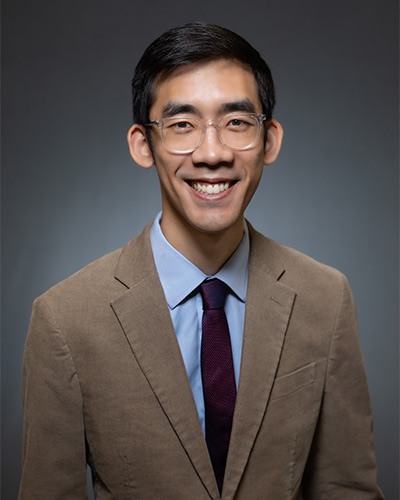Michael Trinh, M.D., Ph.D.: Dr. Richard Mays Smith Award
Few medical students can claim the honor of working in the lab of two Nobel Laureates, but Dr. Michael Trinh has benefited from that exact experience. His thirst for knowledge and drive to succeed, rooted in part by his family’s escape as refugees of the Vietnam War, shaped the person he is today.

What this award means: It is a great honor to be a student recognized by the Department of Internal Medicine.
Mentor comment: Completing his Ph.D. in a remarkable two years, Michael’s work has led to many first-author publications. He also builds excellent rapport with his patients by using a humble curiosity to explore their perspectives and practical daily challenges. Truly an outstanding scholar, Michael will undoubtedly be an academic leader in his field and will succeed at the most competitive and rigorous programs in the country. – Reeni Abraham, M.D., Associate Professor of Internal Medicine
What led to your career path: I was born in Dallas. My parents and their huge families had fled Saigon in the aftermath of the Vietnam War. At the helm of the family was my grandfather, who had been separated from his wife and five children – two of whom were imprisoned in communist “re-education” camps – for 10 years before reuniting with the family in Austin, Texas. It was my grandfather’s mentorship and untimely death from cancer that affirmed my aspiration to study medicine and science.
College: I majored in biology at UT Dallas as part of the UT-PACT Program – a joint B.A./M.D. program that allowed me to matriculate at UT Southwestern after three years of college. As an undergraduate, I worked in the UTSW laboratory of Michael Brown, M.D., and Joseph Goldstein, M.D., whose 1985 Nobel Prize-winning discoveries revealed new information about cholesterol metabolism. While I knew I wanted to be a physician, working with Drs. Brown and Goldstein and seeing how their research made such a big difference in the world inspired me.
UTSW activities: For my Ph.D. research in the Brown/Goldstein laboratory, I used CRISPR gene-editing technology to find genes required for cholesterol to move from one membrane to another in human cells. Genetic defects in this movement can cause fatal human diseases such as atherosclerosis (common) and Niemann-Pick disease, type C (rare). I discovered that this movement requires another lipid named phosphatidylserine, a discovery with implications for membrane biology and cardiovascular science. This work earned me the Merton Bernfield Memorial Award from the American Society for Cell Biology, the William F. and Grace H. Kirkpatrick Award from the UT Southwestern Graduate School of Biomedical Sciences, and the Paul and Daisy Soros Fellowship for New Americans. To bridge my clinical and research interests, I was also President of the Medical Genetics Interest Group and the Seldin Society for Internal Medicine.
Ultimate career goal: To provide the best care for my patients and to discover new biology in the laboratory.
Future plans: I will be headed to an internal medicine residency (Stanbury Physician-Scientist Pathway) at Massachusetts General Hospital, followed by a clinical and postdoctoral fellowship, then become an academic physician-scientist.
About the award: The award is given annually to one or more graduating medical students who excel academically during clinical rotations and exhibit an interest in and compassion for patients.

